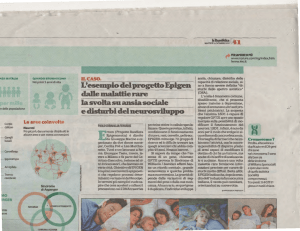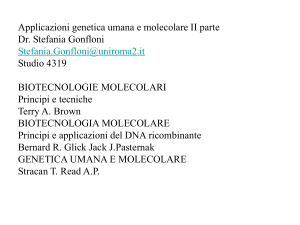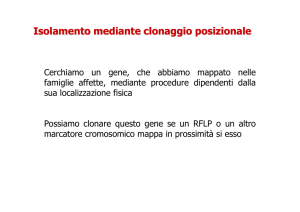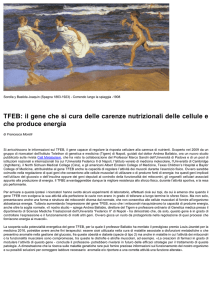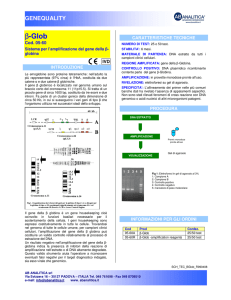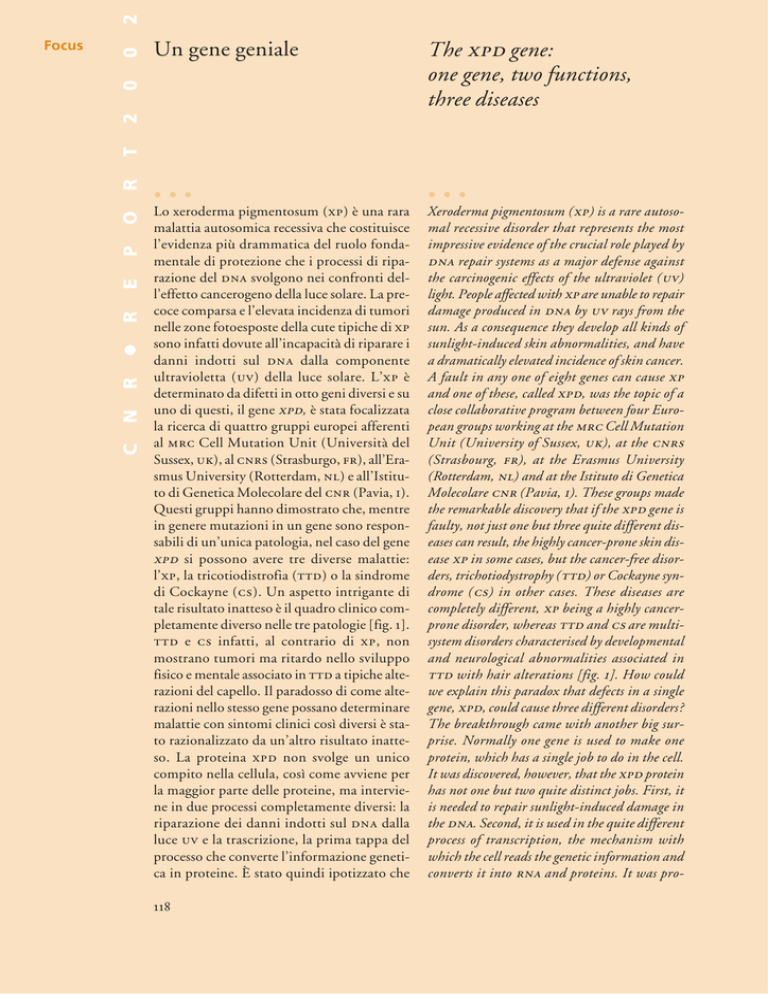
2
0
The xpd gene:
one gene, two functions,
three diseases
Lo xeroderma pigmentosum (xp) è una rara
malattia autosomica recessiva che costituisce
l’evidenza più drammatica del ruolo fondamentale di protezione che i processi di riparazione del dna svolgono nei confronti dell’effetto cancerogeno della luce solare. La precoce comparsa e l’elevata incidenza di tumori
nelle zone fotoesposte della cute tipiche di xp
sono infatti dovute all’incapacità di riparare i
danni indotti sul dna dalla componente
ultravioletta (uv) della luce solare. L’xp è
determinato da difetti in otto geni diversi e su
uno di questi, il gene xpd, è stata focalizzata
la ricerca di quattro gruppi europei afferenti
al mrc Cell Mutation Unit (Università del
Sussex, uk), al cnrs (Strasburgo, fr), all’Erasmus University (Rotterdam, nl) e all’Istituto di Genetica Molecolare del cnr (Pavia, i).
Questi gruppi hanno dimostrato che, mentre
in genere mutazioni in un gene sono responsabili di un’unica patologia, nel caso del gene
xpd si possono avere tre diverse malattie:
l’xp, la tricotiodistrofia (ttd) o la sindrome
di Cockayne (cs). Un aspetto intrigante di
tale risultato inatteso è il quadro clinico completamente diverso nelle tre patologie {fig. 1}.
ttd e cs infatti, al contrario di xp, non
mostrano tumori ma ritardo nello sviluppo
fisico e mentale associato in ttd a tipiche alterazioni del capello. Il paradosso di come alterazioni nello stesso gene possano determinare
malattie con sintomi clinici così diversi è stato razionalizzato da un’altro risultato inatteso. La proteina xpd non svolge un unico
compito nella cellula, così come avviene per
la maggior parte delle proteine, ma interviene in due processi completamente diversi: la
riparazione dei danni indotti sul dna dalla
luce uv e la trascrizione, la prima tappa del
processo che converte l’informazione genetica in proteine. È stato quindi ipotizzato che
Xeroderma pigmentosum (xp) is a rare autosomal recessive disorder that represents the most
impressive evidence of the crucial role played by
dna repair systems as a major defense against
the carcinogenic effects of the ultraviolet (uv)
light. People affected with xp are unable to repair
damage produced in dna by uv rays from the
sun. As a consequence they develop all kinds of
sunlight-induced skin abnormalities, and have
a dramatically elevated incidence of skin cancer.
A fault in any one of eight genes can cause xp
and one of these, called xpd, was the topic of a
close collaborative program between four European groups working at the mrc Cell Mutation
Unit (University of Sussex, uk), at the cnrs
(Strasbourg, fr), at the Erasmus University
(Rotterdam, nl) and at the Istituto di Genetica
Molecolare cnr (Pavia, i). These groups made
the remarkable discovery that if the xpd gene is
faulty, not just one but three quite different diseases can result, the highly cancer-prone skin disease xp in some cases, but the cancer-free disorders, trichotiodystrophy (ttd) or Cockayne syndrome (cs) in other cases. These diseases are
completely different, xp being a highly cancerprone disorder, whereas ttd and cs are multisystem disorders characterised by developmental
and neurological abnormalities associated in
ttd with hair alterations {fig. 1}. How could
we explain this paradox that defects in a single
gene, xpd, could cause three different disorders?
The breakthrough came with another big surprise. Normally one gene is used to make one
protein, which has a single job to do in the cell.
It was discovered, however, that the xpd protein
has not one but two quite distinct jobs. First, it
is needed to repair sunlight-induced damage in
the dna. Second, it is used in the quite different
process of transcription, the mechanism with
which the cell reads the genetic information and
converts it into rna and proteins. It was pro-
T
2
0
Un gene geniale
R
O
P
E
R
R
N
C
Focus
118
2
0
Focus
0
Un gene geniale
T
2
The xpd gene:
one gene, two
functions, three
diseases
C
N
R
R
E
P
O
R
{1}
mutazioni diverse nel gene xpd possano
influenzare in modo diverso la riparazione e
la trascrizione determinando il fenotipo xp
quando solo la riparazione è alterata oppure
ttd o cs quando lo è anche la trascrizione.
La definizione del difetto molecolare in un
numero significativo di casi xp e ttd ha confermato tale ipotesi, evidenziando che i diversi fenotipi patologici sono associati a mutazioni in siti diversi del gene xpd {fig. 2}. L’analisi dei pazienti ttd italiani ha dimostrato
inoltre che nella ttd la gravità del quadro clinico è correlata al dosaggio genico.
È stato infine generato un topo transgenico
portatore di un’alterazione identificata in
pazienti ttd che è risultato avere molte delle
anomalie della ttd, incluse le anomalie del
capello ed il ritardo nello sviluppo fisico.
Questo dimostra che la singola alterazione nel
gene xpd è responsabile di tutti i difetti associati alla ttd.
Questo studio ha quindi permesso di:
– identificare tre malattie ereditarie caratterizzate da un diverso quadro clinico ma
tutte riconducibili a difetti nello stesso
gene, il gene xpd;
– identificare importanti ed inattese relazioni tra la riparazione del dna e la trascrizione;
– spiegare come mutazioni diverse nel gene
xpd possano determinare l’insorgenza di
tre diverse entità cliniche;
– dimostrare che il sito di mutazione nel gene
xpd gene determina il fenotipo patologico.
Questi studi hanno determinato un avanzamento notevole delle nostre conoscenze di
processi cellulari di base di cruciale importanza ed hanno ricadute significative in campo medico con implicazioni nell’ambito della carcinogenesi, del differenziamento, dello
119
{1}
Pazienti affetti da xp (a), ttd (b) o cs (c).
I pazienti xp mostrano precoce comparsa di lesioni precancerose nelle zone fotoesposte della pelle e un’incidenza di tumori
cutanei di almeno 2000 volte più alta rispetto alla norma.
I pazienti affetti da ttd e da cs non mostrano invece alcuna
predisposizione allo sviluppo di tumori. In ttd sono presenti
tipiche alterazioni del capello, ittiosi, ritardo fisico e mentale;
in cs si osservano nanismo cachettico, malformazioni scheletriche, ritardo mentale, microcefalia, progressiva degenerazione
della retina, cataratta e sordità.
Individuals with xp (a), ttd (b) or cs (c).
xp patients show all kinds of sunlight-induced skin abnormalities,
and have an incidence of skin cancer that is 2000 times greater than
that in unaffected people. The defining feature of ttd is sulphurdeficient brittle hair, and there are other developmental defects, but
no significant skin abnormalities and no skin cancers. cs results in
severe physical and mental retardation.
posed that if the fault in the xpd gene affects
dna repair, the individual has xp, but if it
alters transcription, ttd or cs will result. This
hypothesis was supported by the definition of the
sites of mutations in many xp and ttd patients,
showing that the mutations associated with the
three disorders are located at different sites in the
gene {fig. 2}. Furthermore, the analysis of Italian ttd patients showed that not only the site of
the mutation, but also the gene dosage affects the
clinical outcome in ttd individuals.
Genetic engineering was used to produce a
mouse that contained a very specific fault in the
xpd gene found in several patients with ttd
but not in any with xp. The mouse had many of
the features of ttd, including the brittle hair
and small size. This proved that the single alteration in the xpd gene was responsible for all the
defects associated with ttd.
In conclusion, this study has:
– Identified three very distinct clinical entities
associated with defects in the same gene,
xpd;
– Identified remarkable and unexpected links
between dna repair and transcription;
– Explained how different mutations in the
xpd gene result in three different clinical
entities;
– Proven that the site of the mutation in the
xpd gene determines the clinical phenotype.
These discoveries represent major advances in
our understanding of fundamental cellular
processes. They have important impacts on clinical medicine with implications for cancer prevention, genetic diseases, ageing, differentiation
2
0
Focus
0
Un gene geniale
{2}
sviluppo, delle malattie ereditarie e dell’invecchiamento. Per premiare i risultati di
eccellenza ottenuti in questo settore, a questi
gruppi è stato attribuito il Premio Descartes
2000 istituito dalla Commissione Europea. La
ricerca condotta presso l’igm cnr di Pavia è
stata in parte finanziata dalla Comunità
Europea e dall’airc.
cnr
Istituto di genetica molecolare
C
N
R
R
E
P
O
R
T
2
The xpd gene:
one gene, two
functions, three
diseases
{2}
Tutte le alterazioni nella proteina xpd osservate nei pazienti
ttd (sfondo giallo), xp (sfondo verde) e xp/cs (sfondo rosso)
appaiono sempre associate ad una specifica malattia.
La proteina xpd è schematizzata in blu con i domini elicasici in
verde. In bianco sono indicati i cambiamenti aminoacidici, in
nero la sigla dei pazienti. I numeri 1 e 2 dopo la sigla dei pazienti
indicano se uno o entrambi gli alleli contengono la mutazione.
All the alterations in the xpd protein detected in ttd (yellow boxes),
xp (green boxes) and xp/cs (purple boxes) patients are always
associated with a specific disorder.
Blue bar represents xpd protein with helicase domains indicated
in green. White letters: amino acid change, black letters: cell strain
designation. The numbers 1 and 2 after the patient code denote
whether one or both alleles contain the mutation.
120
and development. For their outstanding contribution to work in this area, these teams were
awarded the eu Descartes Prize in November
2000. The work performed at the igm cnr Pavia
was supported by grants from the European
Community and the airc.
cnr
Institute of Molecular Genetics






